
9 Landscape Designer Tips for Creating a Pink Garden
for a soft and romantic atmosphere
Contents
Archetype of the romantic garden, the pink garden is one of the monochrome gardens offering the most possibilities, with pink being the most prevalent colour in the world of flowers. While the options for flowering are numerous, where roses will take centre stage, you will also find a whole range of bushes, perennial plants, and even grasses.
The challenge of the pink garden mainly lies in successfully achieving the right associations of flowers and colours, in the shades of pink that you create, to avoid the overly sweet or candy-like effect that this colour can convey. Foliage, bushes, and grasses will be one of the answers to bring fantasy, volume, structure, or airy movement to the pink garden.
Living the pink life in the garden? It’s possible by avoiding certain clichés and mistakes to create a space that is both soft and full of personality! Discover our tips for designing a harmonious pink garden…

Roses of course, but also bushes, groundcovers, perennial plants, and certain foliage: pink can be expressed in multiple ways in the garden
About the rose...
- Pink is a colour synonymous with romance, softness, and grace. It is one of the colours that can be both fresh in its lighter shades (when it is predominantly tinged with white) or when it takes on blue tones like mauves, and warm when it adopts salmon hues or more saturated reds.
- Like many colours, pink offers a fairly wide palette full of shades in flowering, ranging from white-washed pink, very pale “nymph’s thigh” pink, to candy pink, including vivid fuchsia and raspberry pinks, as well as pinks leaning towards purple or red. There are also orange-tinged pinks with peach roses, tea roses, and salmon pinks. Therefore, pink in the garden allows for quite different atmospheres depending on whether one chooses bright or pastel pinks, and cool or warm shades.
- If pink can be daunting due to its mawkish and outdated connotation, even kitsch, this colour allows for unexpected combinations in a monochrome pink garden, revealing through certain chosen contrasts gardens full of personality.
- One of the advantages of a pink garden is that among the multitude of pink flowers, the desired effect in the garden is assured across all four seasons, with pink flowering being very abundant in spring and summer, but also in autumn and even winter. It is the only colour that allows for such a great variety and such a staggered display throughout the months.
- Its little Achilles’ heel? Pink in the garden does not pair well with yellows… even less so in a monochrome garden. Therefore, you should avoid this unflattering duo in the pink garden.
 Roses are numerous in the garden: pale pink almost white, vibrant Indian pink, striated or maculate pink, bicoloured roses happily paired with white or violet, apricot pink, pink tinged with blue…
Roses are numerous in the garden: pale pink almost white, vibrant Indian pink, striated or maculate pink, bicoloured roses happily paired with white or violet, apricot pink, pink tinged with blue…
For what style of garden?
One inevitably thinks of the romantic garden when discussing the pink garden. While pink is often associated with femininity, this tender colour is, of course, imbued with a great deal of delicacy. It is best used in the following types of gardens:
-
The English or Cottage Garden
This is one of the flagship gardens of the pink garden, a symbol of romanticism. It will feature a beautiful diversity of roses (climbing roses or climbers, old and botanical roses, scented roses), often fragrant climbing plants (clematis, honeysuckles, wisterias, akebias…), lush perennials, blurred forms with soft bushes or trees with a weeping habit… the options are endless in the range of pink blooms. The colours are often pastel, with very soft pinks combined with a few touches of mauve and violet flowers, pure whites, or cream.
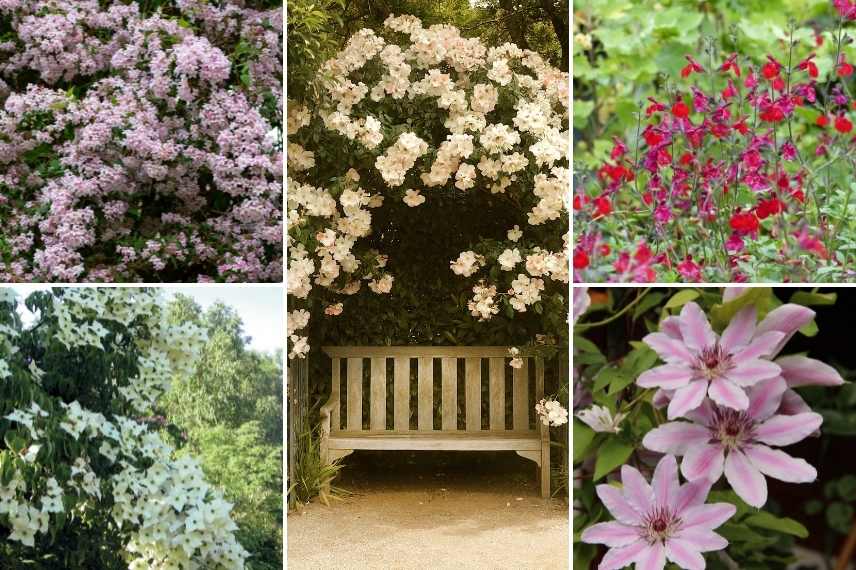
The English pink garden uses many soft forms and a profusion of colours and plants: Here a Kolkwitzia, a Cornus Kousa ‘Milky Way’, an arch of cream roses, a bush sage, and a clematis.
-
The Rose Garden
This is a strong option for the pink garden, primarily composed of old and botanical roses and a few perennials. This garden has the significant disadvantage of being attractive for only 5 to 6 months out of 12, as the perennials are generally summer bloomers. It therefore deserves to at least incorporate, which is frequently the case, a few spring clematis and evergreen plants to ensure volume (usually trimmed into balls to maintain the classicism of the roses). This very romantic garden is more often dedicated to a reserved area in a garden to counter the gaps that occur from December to April.
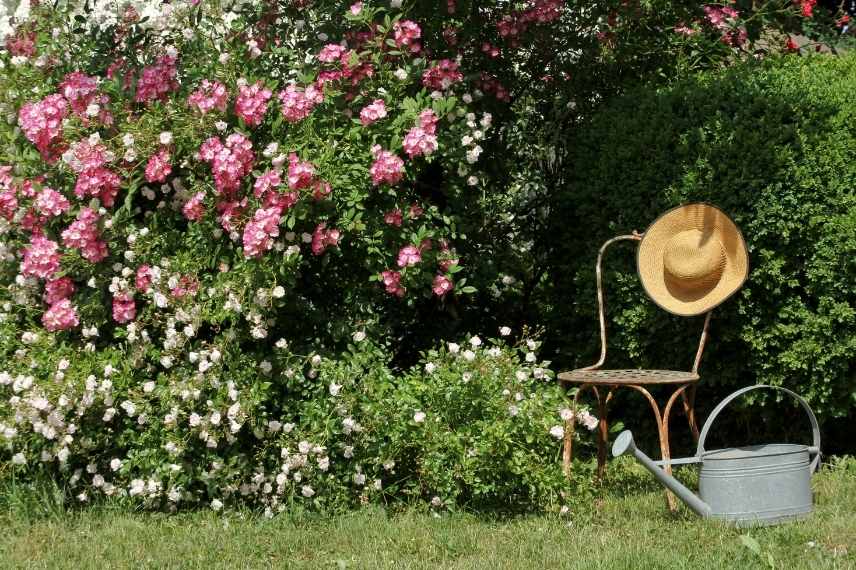 The charm of the rose garden when whites and pinks blend together…
The charm of the rose garden when whites and pinks blend together…
-
The Countryside Garden
The pink garden lends itself well here, provided you choose soft or arching forms such as spiraeas and deutzias, for example, climbing plants including many roses, and combine with bucolic-looking shrubs such as Prunus, pink hawthorns, as well as hydrangeas. A large quantity of silky pink perennials such as Sanguisorbas or field plants like yarrow will be predominant. Again, the foliage will create connections, just like the grasses. White, blue, or mauve pair well in this type of garden, always in small doses.
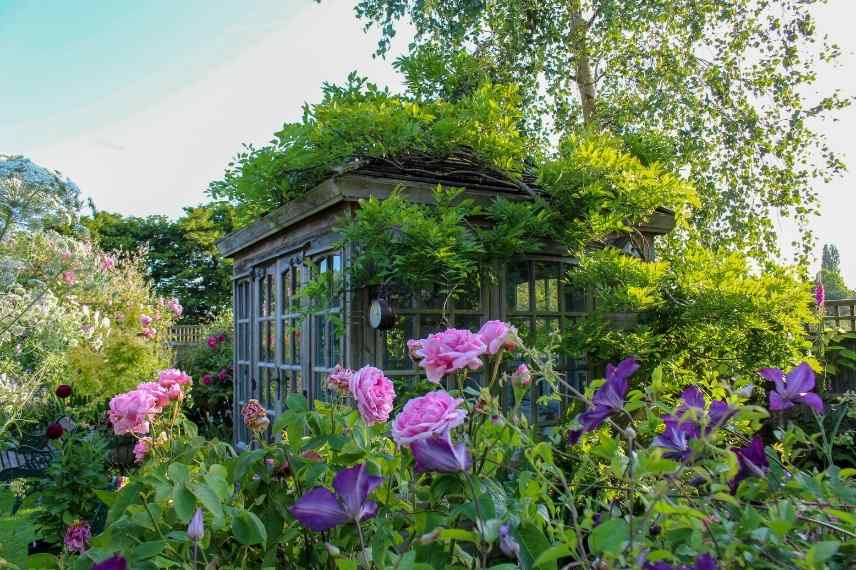 A little corner of the countryside where roses blend beautifully with purple clematis.
A little corner of the countryside where roses blend beautifully with purple clematis.
-
The Japanese Garden
Pink is one of those anti-stress and zen colours appreciated in Japanese-style settings. Pink blooms actually make up a significant part of the spring-flowering shrubs in the Japanese garden. They always elegantly combine with a few white blooms, conifers, and the twisted forms of Japanese maples, giving this type of garden the very soft and soothing atmosphere that characterises it. Among the must-haves are: azaleas and rhododendrons, Pieris, Skimmias, Japanese maples, Magnolias, ophiopogons, pines cloud-pruned, etc.
 Ornamental Prunus, Japanese Maple, Cloud-pruned Conifer, Ophiopogon, Primula japonica, and rhododendrons.
Ornamental Prunus, Japanese Maple, Cloud-pruned Conifer, Ophiopogon, Primula japonica, and rhododendrons.
-
The Coastal Garden
Many frost-sensitive species from the antipodes, such as Grevilleas, Proteas, Bougainvilleas and other Callistemons (bottlebrush), as well as oleanders or tamarisks are very suitable for coastal gardens along the Atlantic and Mediterranean coasts, with pink varieties working wonderfully alongside evergreens like palms, yuccas, or agaves. It is particularly interesting to plant coastal evergreen plants with grey or purple foliage, such as those of Olearias and Leptospermums, Phormiums and Dodoneas, or bright green foliage like that of the Strawberry Tree. Gardens in Brittany with acidic soil will find a wide range of heather soil plants such as Kalmias, Rhododendrons, Pieris, etc.
 Oleander, Arbutus unedo ‘Rubra’, Tamarisk, Phormium, and Grevillea.
Oleander, Arbutus unedo ‘Rubra’, Tamarisk, Phormium, and Grevillea.
-
The Exotic Garden
In this garden, you can incorporate part of the plant palette from the coastal garden, adding largefoliage from perennials or shrubs for a tropical atmosphere, and cacti and succulents to satisfy a desire for a dry and arid garden. Among the well-suited pink blooms are vivid or orange roses and atypical inflorescences: Eucomis, Carpobrotus, Feijoa, Proteas, Asian Lilies... By combining them with a touch of vibrant orange like Aloes or Hedychiums or the intense blue of Echiums (Canary or Madeira Viper’s Bugloss), you will achieve an impression of a pink exotic garden just enhanced by an additional striking touch! Again, choose a single dominant additional colour (orange, red, or blue).
 Eucomis, Protea, banana plant, Carpobrotus, and Aloes.
Eucomis, Protea, banana plant, Carpobrotus, and Aloes.
Pair pink with other colours.
The monochrome garden should highlight its key colour, here pink. However, just like with the blue garden, a garden made up of 100% pink flowers can be a bit cloying, even kitsch in the case of pink.
Pair it with subtle touches of shades that will bring style and delicacy. By tempering with one or two closely chosen colours, the overall effect will remain predominantly pink. The idea is to create harmony rather than contrast in a pink monochrome garden. In any case, choose your “secondary” colour to vary it (blue, mauve and violet or apricot and orange), to avoid multiplying colour effects, lest you stray from the pink monochrome garden. White foliage and flowers will be two important elements to highlight the whole and bring rhythm.
- With white for calming and poetic atmospheres: white can be used as the only secondary colour, or as a neutral third colour, providing a strong link between the flowers. White flowers pair particularly well with “cool” pinks – which contain a hint of blue – to brighten the overall effect. It also works well with pink flowers washed with white, such as certain tulips or peonies, but in this case, always insert a flower of a more vibrant pink to avoid a decor that is too pale.
- With blue for very romantic and fresh scenes: an ideal pairing for summer blooms, creating an immediate sense of freshness… and in small gardens where blue enlarges the space. Also stunning in large gardens!
- With green which pairs particularly well with pink. Green is opposite pink on the colour wheel (although pink does not actually appear on this famous colour wheel), and several shades are interesting with pink: aniseed greens (chartreuse) and golden greens for a tangy effect, white-variegated greens to bring in light, or conversely, greyed greens for a more relaxing atmosphere. Avoid dark and sombre green foliage with “cool” pinks.
- With orange tones for a graceful atmosphere in a pastel spirit: these will be apricot oranges for very soft harmonies… Some pink flowers are then salmon or tea rose, and many carmine roses. Be careful not to stray too far from the dominant pink!
- With purple for theatrical and baroque atmospheres: Again, a beautiful association with pink, more pronounced and assertive, which is best not used in a large space, but in a specific area. It will therefore be better suited to small gardens: think of Japanese maples, Prunus, Cotinus and Cordylines, as well as Hellebores, certain Magnolias and Irises, etc. Ideal if you are creating a Japanese-style garden!

The purple of a maple enhances the pink flowers, while the whiteness of the irises and clematis illuminates the scene.
→ Discover many examples in our advice sheet : Pairing pink flowers
Focus on foliage
By punctuating the beds with evergreen bushes or those with remarkable foliage due to its size, colour changes, or shape, you add a verdant touch that will twist the innocence of pink flowers.
It is therefore very interesting to introduce volumes and focal points. Play particularly with the structure and movement of certain foliage: they will play a significant role in providing contrast or light within the pink wave of the garden!
You will choose them sometimes in shades of purple, a perfect colour that always harmonises well with any shade of pink flowers (it pairs well with both candy pinks and orangey pinks), sometimes greyed to enhance the softness of pink, sometimes in acid green to brighten the whole and bring a lot of freshness.
→ Some ideas for colourful bushes for contrast: Cotinus and Sambucus nigra, Albizia julibrissin ‘Summer Chocolaté’, Dodoneas, Cordylines, variegated Phormiums in purple or bronze…
→ Some ideas for acid green, purple, or greyed perennials for contrast: alchemillas, Carex, Euphorbias, Heuchera ‘Citronelle’…

Thalictrums, Alchemilla, Leptospermum scoparium ‘Martini’, rosemary, Sedums, Phormium ‘Platt’s Black’, and Acer palmatum ‘Dissectum’
Play with inflorescence shapes
Pink flowers may get a bit lost in an excess of pink if you compose solely with similar shapes.
To personalise and add a bit of flair to this sometimes too demure pink, in addition to the various shades of pink you select, play with the inflorescences offered by the wide palette available: pink flowers can also surprise with their boldness when they take on original shapes or textures, such as Albizia, Cleomes, Podranea, or Protea… among others!
So vary the inflorescences with ball-shaped flowers like hydrangeas and alliums, upright spike forms like Acanthus, Digitalis, or Veronicastrums, trumpet-shaped flowers like Lilies, flowering in short stems like Achilleas, tulip or inverted cup shapes of Magnolias, capitula flowers like Echinaceas, star-shaped flowers, in umbels or thyrses, etc.
This fabulous diversity of shapes among pink flowers is visually appealing, punctuates the scenes, and makes one forget the monochrome of the pink garden.

Callistemon, hydrangea, bleeding heart, Dahlia, Veronicastrums, Echinaceas, and Erigeron karvinskianus
Fall in love with the most beautiful pink flowering.
As mentioned, pink flowers are among the most prevalent in the vegetable kingdom. It is therefore impossible to list them all here, but here is a short selection of essential pink flowerings for creating a monochrome pink garden, or at least those that are easy to establish, with remarkable flowers, showcasing impressive shades of pink, for a garden that blooms in pink for a long time.
The species or varieties proposed below are listed in chronological order of flowering, from spring to winter, within each category:
- Trees and bushes: Daphnes, Magnolias, numerous acid-loving shrubs such as Azaleas and rhododendrons, Camellias, Kalmias and Pieris, ornamental Crab Apples, Flamingo Willow, Leptospermums, Hydrangeas, Hibiscus (syriacus and moscheutos), Cotinus coggygria, Albizia, Lagerstroemias, Camellias sasanqua, Prunus subhirtella ‘Automnalis’, Viburnum bodnantense, etc.
- Perennials: Bergenias, Astrances, Peonies, Digitalis, some lupins and Gauras, Phlox, Persicaria, Corncockle, Asters, Oriental Hellebores… and many more
- Climbers: Passiflora ‘Perfume Passion’, numerous clematis and some honeysuckles, bougainvillea, climbing roses, Pandorea, Jasminum beesianum…
- Bulbous plants: Crocus, Hyacinths, Tulips, Gladiolus, Lilies, Cannas, Alstroemerias, Tulbaghias, Dahlias, Canna lilies, Nerines…
- Annuals: Cosmos, Cleomes, sweet peas…
- Grasses: several offer their very pink spikes starting in September… they are magical for completing the pink palette with an incomparable lightness (Eragrostis spectabilis, Muhlenbergia capillaris, Miscanthus sinensis ‘Graziella’, Miscanthus sinensis ‘Dronning Ingrid’, Pennisetum orientale ‘Karley Rose’…)
- Groundcovers: various Epimediums, hardy geraniums, Pulmonarias, Delospermas…
→ Read also: 5 pink-flowering trees for a radiant garden.
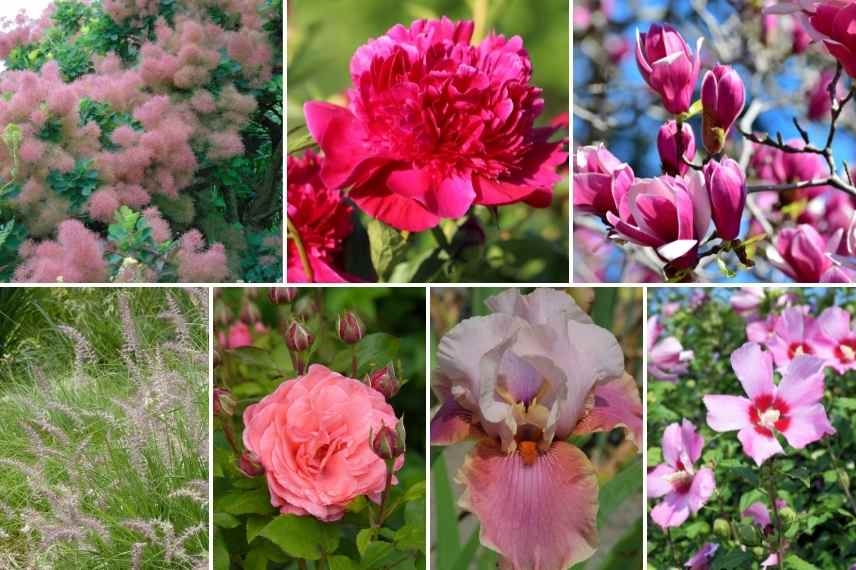
Cotinus coggygria, Peony, Magnolia liliflora, Pennisetum orientale ‘Karley Rose’, rose ‘Elaine Paige’, Iris ‘Cameo Wine’, Hibiscus syriacus
Pay attention to exposure.
The great diversity of pink flowerings allows for installation either in full sun, partial shade, or shade depending on the species and cultivar. This is one of the many advantages of this colour.
Once you have ensured this essential requirement for the plant, just remember a few notions of light. In full sun, pink flowers will benefit from being used in deeper pink shades, so they are not washed out by the intensity of the light rays. Conversely, in the shade, opt for lighter pinks or combine vibrant pinks with whites, cream shades, or variegated foliage. Pink flowers tinged with blue will convey a more somber note in a shaded context.
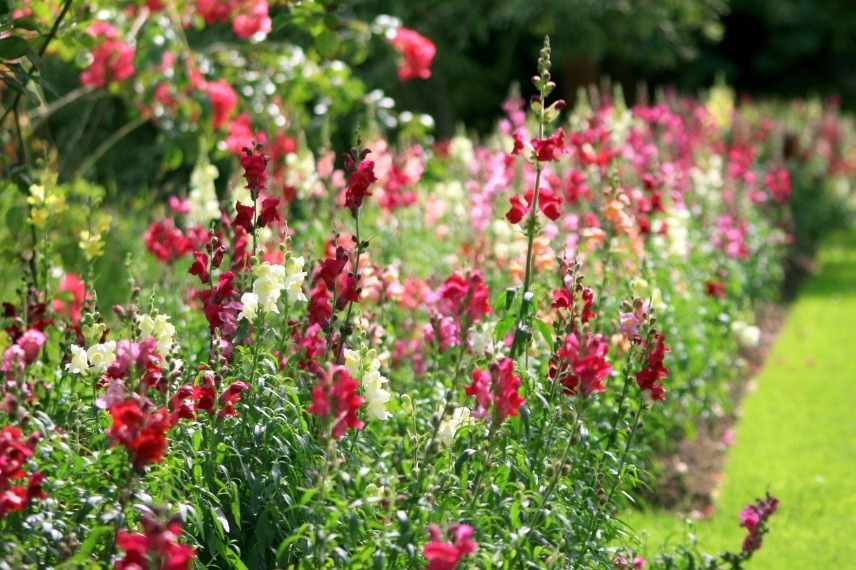
Combine some bright pink flowers in a border exposed to the afternoon sun.
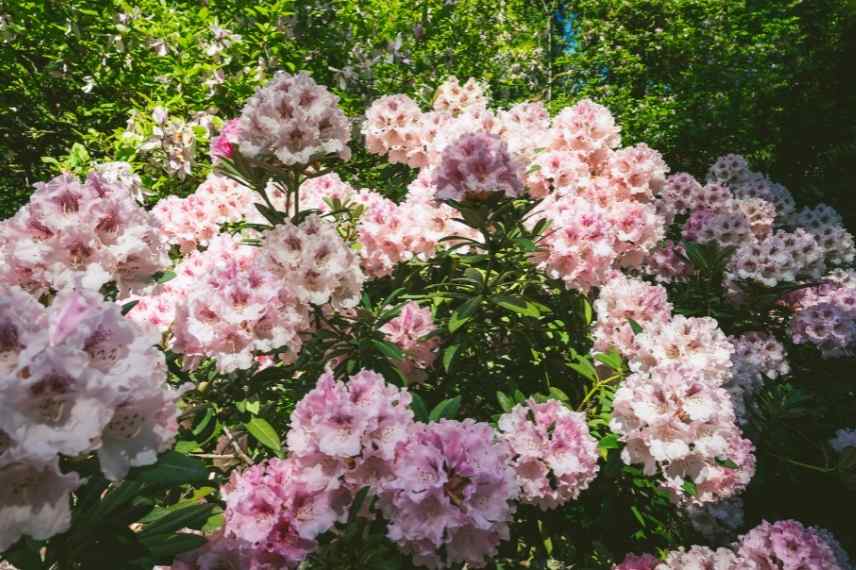
Pale pink rhododendrons brighten a partially shaded corner of the garden.
Furniture and materials
Materials shape your garden, dressing its lines while furniture adds decoration and a significant splash of colour.
In the case of a monochrome pink garden, still aiming to avoid visual saturation, do not add pink for example in the pots placed on a terrace or in window boxes. Simple materials are the most coherent, especially in the context of a romantic or English-style garden: raw wood, white-painted or stained wood, wrought iron or wicker chairs, local stone borders… Anthracite grey is also a good option for furniture, as like white, it serves as a neutral colour and will bring a more modern touch.
However, if you are designing your garden by the sea or have opted for an exotic garden, you can indulge in a little colourful whimsy, which will further spice up these vibrant gardens: a Tyrian pink fence, or even a red bench or a blue garden shed if you have introduced this colour as a secondary shade in the garden. But limit this strong colour addition to a single element, like a cheeky nod to your entirely pink garden!
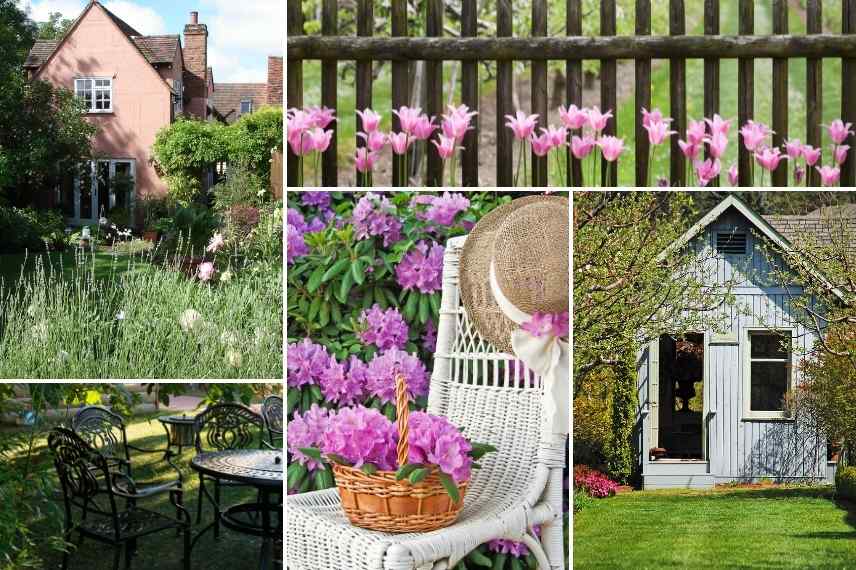
One can start from a salmon pink house like this to compose their pink garden! A pastel blue garden shed accompanies white furniture chosen for freshness or black for sobriety. Natural fences beautifully highlight the pink flowers.
Draw inspiration from gardens and books!
Before you embark on a pink garden, don’t hesitate to visit gardens, or simply take a stroll through your city’s botanical garden: annual flowerings are often studied by colour theme, and pink is frequently included! This will allow you to see if this type of arrangement appeals to you, as a monochrome pink garden is a unique choice.
I also recommend a few useful books:
- Roses in their Natural State, Secrets of a Passionate Rosarian. Eléonore Cruse. Ed. Ulmer. 2018: a lovely stroll through Berty’s rose garden in Ardèche.
- The Colour Guide for the Garden. Francis Peeters and Guy Vandersande. Ed. Ulmer. 2016. A bible on the use of colour!
- The Gardener’s Colour Book. Andrew Lawson. 2020. Ed. Jardins et Nature. Another reference work to better master colour in the garden.
- Subscribe!
- Contents
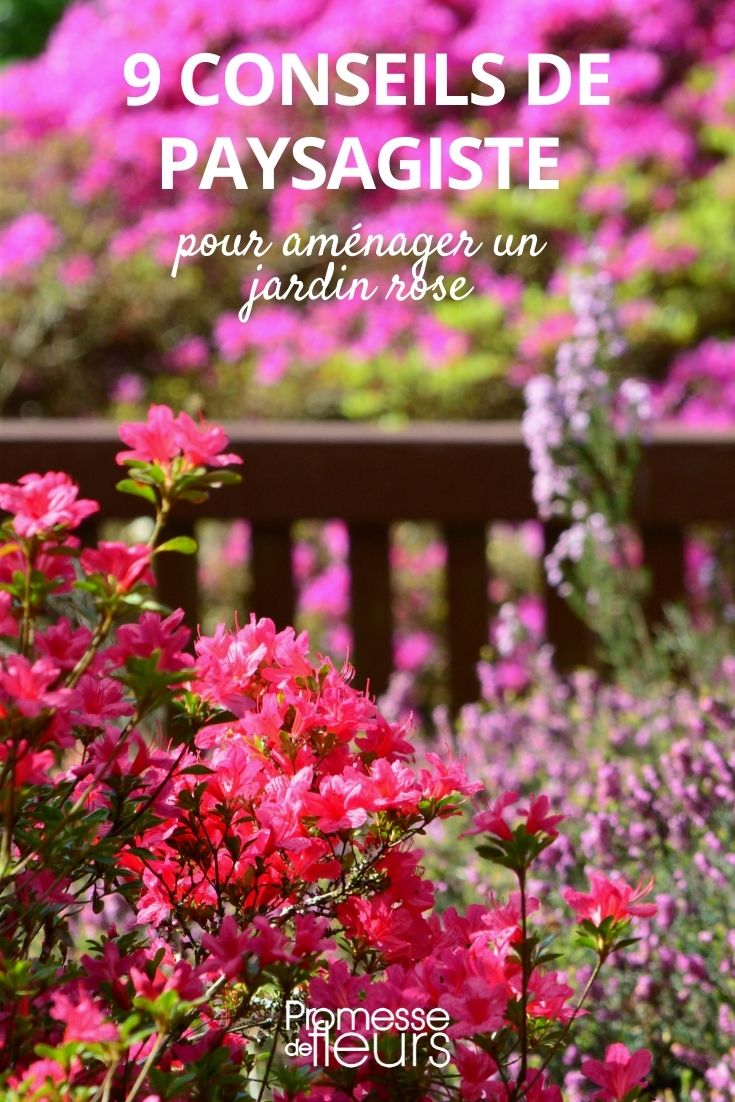































Comments